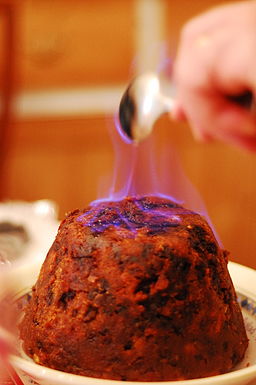




Christmas pudding photo courtesy of Jay Springett on Wikimedia Commons.
Today’s recipe is another repeat from a few years ago—hope you enjoy it!
Ah, the Christmas pudding. Banned by the Puritans, feared by the (modern) Americans, loved by (most of) the British. My husband has been making Christmas pudding to scare my family with for years, as it simply isn’t Christmas for him without one. As for me, my thoughts on Christmas pudding are this: meh.
It’s a marvelous thing to see on Christmas day, after it has been steamed for a few hours, doused with brandy and set alight before bringing it to the table. When my nephews were a wee bit smaller than they are now (let’s just say they are much, much taller than I am these days), their eyes would grow to saucer-size at the sight of a dessert actually on fire. But no way were they going to eat it.
This is another Christmas tradition that can be made months in advance, ideally six. (No, that has never been managed in my household.) Much like the Christmas fruitcake, full of dried raisins, cranberries, cherries, figs, whatever you like (no scary candied fruits, please!), some cloves, a few eggs, some nutmeg, a bit of flour, brown sugar, bread crumbs, butter, ginger, and most important, the booze: 1/2 cup of rum and 1/3 cup of cognac or brandy. (Though you don’t necessarily need to use both.) Steam for about two hours.
On the day, you steam it again for another 45 minutes or so, douse it in brandy, and set it alight. Usually served with a side of brandy butter: butter, sugar, and brandy all mixed together. My husband has also always been in charge of that particular mix, and all I know is it’s equal parts butter and sugar with as much brandy as the mix can take. Good luck.
As it is the festive season and I’m feeling a bit tired and unoriginal, I’m giving you, dear readers, a repeat post from 2011. The Mysteries of Christmas Cake–Unveiled (Sort of). Enjoy!
* * *
Ah, the Christmas cake, or “fruitcake” as it is fondly (and not so fondly) known. In the UK, they call it “rich” fruitcake, though the reason escapes me a bit–I think it’s because there is more dried fruit in it than in a “regular” fruitcake.
Now in the States, we abhor the fruitcake. We love to hate it, don’t we? I’ve never tried an American fruitcake and I don’t believe I ever will–all those green and red and orange candied fruits look, well, pretty gross. This is one thing British fruitcake has going for it–none of that scary stuff. But I have to say, it’s scary in its own right. My husband made the Christmas cake this year, a bit late (he waited until November when ideally it would’ve been done in early- to mid-June).
Here’s what the batter looked like pre-baking:
The blue paper is wrapped around the outer edge of the pan to keep it from burning. In Simon’s family, it’s traditional to use this particular blue paper (it’s actually a bag from the pharmacist saved year-after-year for the purpose, don’t ask me why). The paper is tied on with a string, also saved from year-to-year, and the batter must be stirred by the children of the family so they can make a wish and for good luck. (Perhaps they wish for a good excuse to not eat the Christmas cake.)
After all that, the cake is baked for a good four or five hours (the thing is enormous) and then set aside to cool and be iced with marzipan and tucked away for Christmas Day. I’ll post a photo of the end result here in a bit.
So what goes in a Christmas cake, exactly? Here’s a recipe that would have been used in large manor houses round about 1845:
Cream the butter and whisk the eggs. Add flour and eggs to the butter and mix well until a stiff batter is formed. Add in the fruit and treacle. Mix the cake by hand (it will burn out a modern electric mixer). Turn it into a well-greased 9-inch tin and bake in a moderate oven (140 degrees Celsius/280 Fahrenheit) for about 5-6 hours. Wrap the tin in several layers of paper to stop the edges of the cake from burning.
Anyone want to give it a try and let me know how it turns out? We bought rolls of prepared marzipan to lay over the finished cake; for a view of what a finished product might look like, check here (ours looks nothing like these).
For a really large cake, the recipe recommends 10 lbs. of fruit, 8 lbs. of flour, 8 lbs. of butter, 2 lbs. of candied peel, about 50 eggs, and a little treacle. (If you make that one, do let me know. And send pictures.)
Here’s another recipe I pulled out of a magazine over a year ago with a view to making and sharing on the blog. Parkin cake is, apparently, a tradition in the North of England and not the South, where we live—which may explain why I’d never heard of it before. It dates back to about 1728 and is associated with Guy Fawkes night, or bonfire night, when Brits celebrate the man who tried to bring down the government by blowing up the Houses of Parliament. He failed and was hung, drawn, and quartered. Ouch.
Parkin cake was known as the cake of the poor, because it used oats—the staple grain of the poor—as one of its main ingredients and was traditionally made in early November, after the oats were harvested, which is probably why it became associated with bonfire night, the 5th of November. Essentially, it’s a gingerbread with oatmeal in it and makes a tasty snack on a cold autumn night.
Parkin Cake
Serves 12-15
100g / 4 oz / .5 cup butter
100g / 4 oz / .5 cup soft dark brown sugar
1 tbsp black treacle/molasses
4 tbsp golden syrup/corn syrup
225 g / 8 oz / 2.5 cups oatmeal
100 g / 4 oz / 7/8 cup self-raising flour
1 tsp bicarbonate of soda/baking soda
pinch of salt
2 tsp ground ginger
2 beaten eggs
2 tbsp milk
Enjoy!